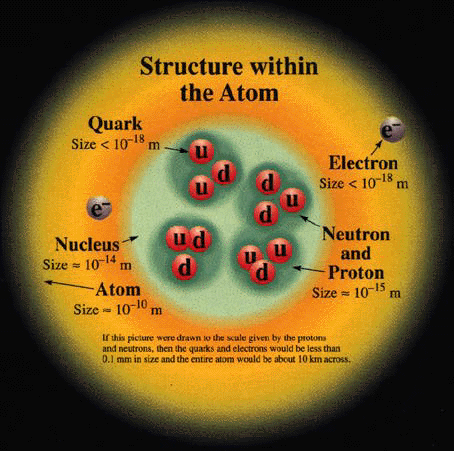University of California, San Diego
Physics 7 - Introduction to Astronomy

 |
Physics 7
The Scale of the Universe |


- The Atom -- the basic unit of every chemical element is the
atom, consisting of the nucleus, composed of
protons and neutrons held together by the
Strong Force, with electrons "orbiting"
the nucleus, attracted by the
Electrical Force.
|
Atomic Particles |
| Particle |
Symbol |
Charge |
Mass
( g g
 ) )
| Mass
( amu amu
 ) )
| Family |
| proton |
p+ |
+1 |
1.673 x 10-24 |
1.00727 |
baryon |
| neutron |
n0 |
0 |
1.675 x 10-24 |
1.00866 |
baryon |
| electron |
e- |
-1 |
9.109 x 10-28 |
5.485 x 10-4 |
lepton |
- Atomic Nuclues -- ~10-13cm.
- Size of Atom -- the radius of the first electron "orbit" in
the Hydrogen atom is
1/2Å = 0.5 x 10-8cm.
The ratio of the size of the atom to the size of the nucleus is about 100,000;
if the atomic nucleus were a pingpong ball (r ~ 1cm) its electrons would be
in orbits about a kilometer away.
- Molecules - Atoms build themselves into molecules
(e.g. H2O) with sizes ranging
from a few Å to the largest molecules,
such as DNA,at up to 10 cm.
- Cells - 10-2 cm.
- Humans - The largest humans who don't play basketball are
about 2 meters in size; Professor Smith is
186 cm in height.
- The Earth - The earth is about 25,000 miles around, implying
a radius of about 4000 miles. More precisely, the
equatorial radius, RE = 6378 km =
6.378 x 108 cm. In other words it
would take about 7 million people to span the
distance from San Diego to China through the
center of the Earth.
- The Sun - the Sun, our nearest star is 93 million miles or
about 150 million km = 1.5 x 1013cm away.
It has a size, RS = 7 x 1010cm.
If the sun were a large grapefruit (r ~ 7cm) the earth would be a pinhead
15 meters away.
- The Stars - the nearest star, Alpha Centauri, a triple star
system visible from the Southern Hemisphere
in the constellation Centaurus, is 4.34 light
years = 4 x 1018cm away.
A light year is the distance light travels in a year = 3 x 1010
cm/second x 60 seconds/minute X 60 minutes/hr x 24 hrs/day x 365 days/yr
~ 1018 cm. If the sun were a grapefruit in San Diego, the next
grapefruit would be 2500 miles away.
- The Galaxy - The Sun and Alpha Centauri are among about half
a trillion stars in the Milky Way Galaxy, which
is about 100,000 light years =
1023cm across.
- Other Galaxies - The Andromeda Galaxy, our nearest sizeable
neighbor is about 2 million light years
= 2 x 1024cm away.
- The Universe - 1027cm: there may not be a "size"
to the Universe; it may be infinite, but a
crude estimate of the
scale of the Universe can be made from the
fact that the Universe began with the
Big Bang some 10 - 20 billion years
ago. Thus the most distant objects that we
can see are about 10 billion light years
= 1027cm away.
From the size of the atomic nucleus, important for the fusion energy of the
stars, at 10-13cm, to the scale of the
Universe as a whole ~ 1027cm, the distance scales of interest in
Astronomy span a factor of about 1040 -- 40 orders of
magnitude!
Powers
of ten a visual depiction of the scale of the Universe starting at
10 million l.y. from the Milky Way and zooming into the heart of the atom.

 Through the Universe at the Speed of Light
Through the Universe at the Speed of Light
 Physics 7 Lectures
Physics 7 Lectures
 Physics 7 Home
Physics 7 Home
Conducted by Gene Smith, CASS/UCSD.
Comments?
You may send email to hsmith@ucsd.edu
Prof. H. E. (Gene) Smith
CASS 0424 UCSD
9500 Gilman Drive
La Jolla, CA 92093-0424
Last updated: 16 April 1999




![]() Through the Universe at the Speed of Light
Through the Universe at the Speed of Light
![]() Physics 7 Lectures
Physics 7 Lectures
![]() Physics 7 Home
Physics 7 Home